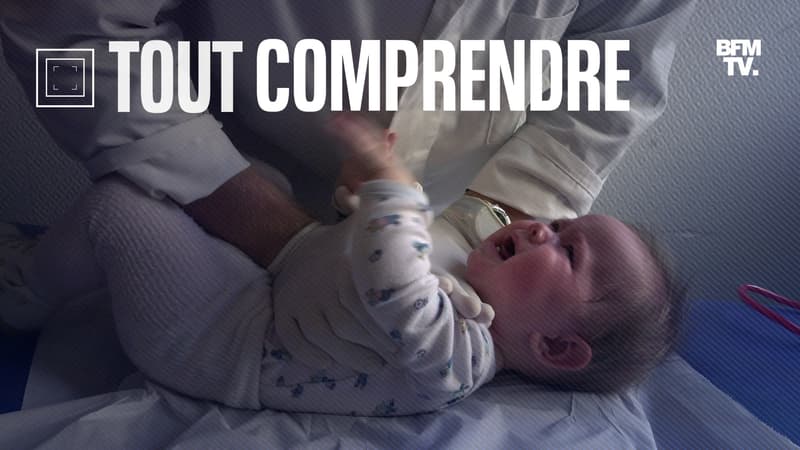Faced with an epidemic of bronchiolitis of unprecedented virulence for more than ten years, the Minister of Health, François Braun, announced on Wednesday the implementation of the national plan provided for in exceptional health situations in all French hospitals.
“I decided this morning, in addition to everything that was already mobilized, to activate the ORSAN plan (organization of the response of the health system in exceptional health situations) specific to this epidemic, to further strengthen the means of the ARS (regional health ). agencies) and allow the entire hospital to focus on this particularly acute problem today,” he told the Senate.
Before this announcement, the ARS had communicated several activations of white plans (being able to mobilize personnel, reorganize services and deprogram) – for example in Brittany, Auvergne-Rhône-Alpes, or even New Aquitaine where the level 2 white plan in Gironde had been triggered.
• What is bronchiolitis?
Bronchiolitis is an infection of the small bronchial tubes, most commonly caused by a very common and highly contagious respiratory syncytial virus (RSV). It is seen in children under 2 years of age, a third of whom suffer from it each year, and especially in infants under eight months.
The epidemic has a strong seasonal upswing: it generally begins in mid-October and ends in late winter with a peak during the month of December.
Before the age of two, it is estimated that more than 90% of children have had at least one infection with this virus, without consequences in the vast majority of cases. However, very young children, especially those younger than two months, can have more severe forms that may require hospitalization, sometimes in intensive care.
• How is it transmitted?
Many people carry the virus and are contagious without knowing it because adults and older children who carry the virus usually have no signs or just have a cold.
It is easily spread through saliva, coughs, and sneezes, and can remain on hands and objects (such as toys, pacifiers, comforters).
To protect their children, parents can adopt simple and effective barrier gestures and behaviors: limit visitors, wash their hands, wash toys and duvets regularly, wear a mask or ventilate the rooms.
• What are the symptoms?
Bronchiolitis begins with a simple cold with a stuffy or runny nose and a mild cough. Then the cough is more frequent, breathing may become wheezing. The child may have difficulty breathing and have difficulty eating and sleeping. Sometimes he has a fever.
In most cases, bronchiolitis resolves spontaneously after 5 to 10 days, but the cough may persist for 2 to 4 weeks.
• What to do in case of contamination?
If a baby is sick, go to the doctor. The examination of the baby allows to make the diagnosis of bronchiolitis and assess its severity, underlines the Health Insurance.
Depending on the infant’s age (particularly if it is less than 2 months), its health status and the severity of the bronchiolitis, the doctor judges the need for possible hospitalization for follow-up.
But in some cases, it is better to call 15 directly: if the child is less than six weeks old, if he is a former premature infant less than three months old, if he already has an identified respiratory or cardiac disease, if he drinks less than half of his bottles in three consecutive meals or vomits systematically, if he sleeps constantly, or on the contrary, cries unusually and cannot fall asleep.
• How to relieve the child?
The doctor usually advises cleaning the nose with nasal washes. Indeed, the infant under 6 months breathes only through the nose and does not know how to do it through the mouth. For him to drink and eat enough, he must be offered water regularly and frequently, to avoid dehydration; continue to feed him normally by dividing his meals and offering small amounts if he is tired. Vomiting is common during coughing episodes.
Apart from certain situations assessed by the doctor, respiratory physiotherapy is no longer recommended by the High Health Authority since November 2019 during a first episode of bronchiolitis in infants.
Antitussives, expectorants and diluents are contraindicated in children under 2 years of age, remember the health insurance. Also, since the infection is viral, antibiotics are useless.
• What are the figures in France?
Public Health France indicates that, for the week of October 31 to November 6, 2022, hospitalizations for bronchiolitis account for 50% of hospitalizations following an emergency room visit in children under two years of age. By comparison, this percentage hovered around 40% during the peaks of previous seasons.
Of the 6,891 children under 2 years of age seen in the emergency department for bronchiolitis last week, 92% were under 1 year of age and 2,337 (34%) were hospitalized.
• Are there vaccines?
The European Union has approved a preventive treatment capable of preventing severe forms of bronchiolitis in all babies, announced this Friday the AstraZeneca and Sanofi groups, which are developing it. These synthetic antibodies will not be available before the 2023 season.
Following respective Friday press releases from Sanofi and Astrazeneca, the European Commission confirmed to BFMTV that it had authorized Beyfortus’ treatment on Monday 31 October. A decision that entered into force on Thursday, November 3, after acknowledgment of receipt by the company. This treatment is also currently being tested as part of the Harmonie study in France.
The American Pfizer has also just announced the positive results of an anti-RSV vaccine, paving the way for its future approval.
Source: BFM TV


